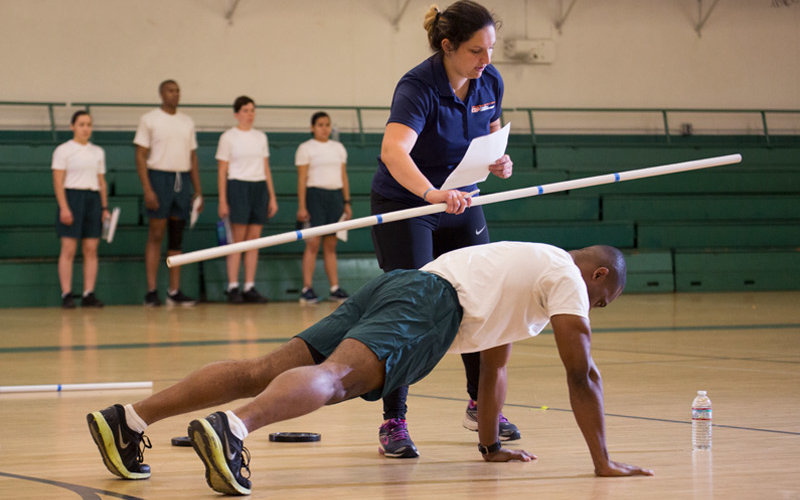
An opportunity to expand their learning experience beyond the classroom has landed Cal State Fullerton students on the training field with Los Angeles County Sheriff’s Department custody (detention) assistant and deputy sheriff recruits. The collaboration, now more than a year old, has benefited more than 30 kinesiology majors.
The experiences and research garnered has resulted in numerous conference presentations, as well as seven manuscripts published or accepted for publication in peer-reviewed journals.
“The original inquiry was to check to see if physical fitness training was an issue with recruits being injured in the field,” explains Robert Lockie, assistant professor of kinesiology and an athletic performance researcher whose doctorate is in biomechanics, strength and conditioning.
“The field work has given students plenty of hands-on practice and a wide range of experiences — operating in different scenarios, making quick decisions and even role playing to understand recruits’ motivations and reactions to the training.”
This semester, graduate kinesiology student Karly Cesario ‘17 (B.S. kinesiology-strength and conditioning) was tasked with designing a physical training program for the current custody assistant recruit class. Fellow graduate and undergraduate students assist her as they run the program, gather data on results and make adjustments so that the program provides recruits with the maximum benefit from the training.
The goal is to improve the physical fitness and health of recruits, and reduce attrition, explains Lockie. “There were no real fitness standards — just some health screening.”
The cadets are run through a program of ability-based running, strength exercises and calisthenics. Their efforts are overseen and monitored by five kinesiology majors.
“There was a lot of collaboration and discussion that went into developing the program,” says Cesario. “And just like most programs, it has evolved a bit as we have worked closely with the LASD.
“I was given a lot of freedom with the design and have done my best to use past research and experience to guide the program’s direction,” he adds. “I am lucky to have guidance from Dr. Lockie and his network.”
“We pretested eight cadet classes in 2017 and so far have run two additional classes this year,” says Lockie. “Each class can range from about 60 up to 100 recruits.”
The feedback has been good, notes Cesario. “Change is always hard, especially in a tradition-based organization like this one, but, none of this would be possible without the support and willingness of the sheriff’s department staff.”
“I was surprised at how friendly and receptive the department was in our efforts,” Lockie agreed.
“Now I have a new future goal and outlook into what I can do,” says Blake Carlock, a senior kinesiology-strength and conditioning major. As part of the training effort, Carlock checks that the recruits are doing the tasks correctly to help improve their fitness and lessen injuries, and collect data on the recruits’ results. The experience has expanded his range of experiences to speaking before groups and giving direction — all aspects that boost his confidence of what he can do and achieve. “This is my opportunity to get into areas I never considered, a future working with police, fire, search and rescue or the military.”
Cesario agrees. Her future goals are to work in the private sector as a strength and conditioning coach but noted that working with tactical athletes “presents a unique challenge as a coach and I hope to continue to grow in this area. … this opportunity is amazing and will definitely shape my career path moving forward.”
“I never expected that the university I’m attending would offer the opportunity to study and work in this particular aspect of fitness,” says Carlock.